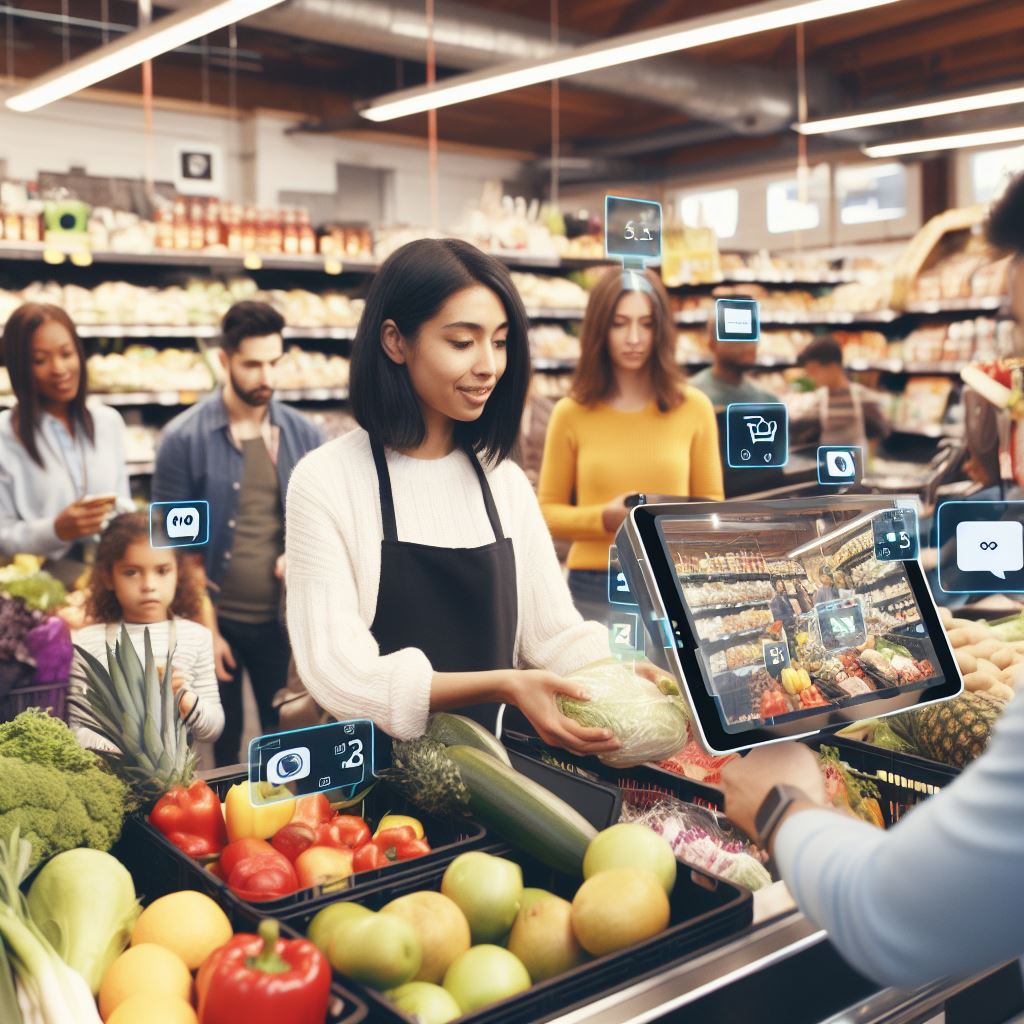How Grocery Stores Are Affected by SNAP Benefits

Imagine stepping into a grocery store bustling with activity, the aisles filled with shoppers seeking sustenance.
As you navigate through the crowds, you may not realize the profound impact that SNAP benefits have on this environment.
From increased foot traffic and sales to expanded product offerings and pricing strategies, grocery stores are intricately connected to the world of SNAP benefits.
In this article, we will explore the ways in which these benefits shape and transform the grocery store landscape.
Key Takeaways
- Accepting SNAP benefits leads to increased foot traffic and sales.
- Expanded product offerings and variety attract more SNAP beneficiaries and tap into new markets.
- Pricing strategies should be carefully assessed to ensure optimal pricing and attract customers.
- Staff training and excellent customer service enhance the overall shopping experience and drive positive word-of-mouth recommendations.
Increased Foot Traffic and Sales
When you accept SNAP benefits at your grocery store, you can expect an increase in foot traffic and sales. The Supplemental Nutrition Assistance Program (SNAP) serves as a safety net for millions of low-income individuals and families, providing them with funds to purchase food. By accepting SNAP benefits, you open the door to a wider customer base, as approximately 39.7 million Americans were enrolled in SNAP as of 2020.
With more people able to afford groceries, it’s only natural that foot traffic in your store will increase. Studies have consistently shown a positive correlation between accepting SNAP benefits and increased sales. For instance, a study conducted by the United States Department of Agriculture (USDA) found that SNAP participants spent more money on groceries compared to non-participants. This increase in spending translates into higher sales for grocery stores that accept SNAP.
Moreover, accepting SNAP benefits can also lead to increased sales of non-SNAP eligible items. Research has shown that SNAP participants tend to purchase more than just essential food items when they visit grocery stores. They often buy additional products such as personal care items, cleaning supplies, and even alcohol. Therefore, by attracting SNAP participants to your store, you have the opportunity to boost sales across various product categories.
Expanded Product Offerings and Variety
To capitalize on the increased foot traffic and sales resulting from accepting SNAP benefits, you can expand your product offerings and provide a greater variety to meet the diverse needs of your customers. By offering a wider selection of products, you can attract more SNAP beneficiaries who are looking for nutritious and affordable options. This can lead to an increase in sales and customer loyalty.
Expanding your product offerings can also help you tap into new markets and attract customers who may not be SNAP beneficiaries. By including specialty items, organic products, and international foods, you can cater to a broader range of tastes and preferences.
In addition to attracting new customers, offering a greater variety of products can also increase the average transaction size. Customers are more likely to spend more when they’ve more options to choose from. This can lead to higher revenue and profitability for your store.
Furthermore, providing a diverse range of products can enhance the shopping experience for all customers. It creates a sense of inclusivity and allows individuals to find products that align with their dietary restrictions, cultural backgrounds, and personal preferences.
Pricing Strategies and Challenges
Expanding your product offerings and providing a greater variety can also present pricing strategies and challenges for your grocery store.
As you introduce new products, it’s crucial to assess their demand and determine the optimal pricing strategy to maximize profitability. Data-driven pricing strategies can help you make informed decisions based on market trends and customer preferences.
One pricing strategy you may consider is cost-based pricing, where you calculate the product’s cost and add a desired profit margin. This approach ensures that you cover your expenses while maintaining a competitive price. However, it’s essential to monitor the market to ensure your prices align with customer expectations and competitor offerings.
Another approach is value-based pricing, where you set prices based on the perceived value of the product to customers. Conducting market research and understanding your target audience’s preferences and willingness to pay can help you determine the product’s perceived value accurately.
Challenges may arise when setting prices for a wide range of products. It’s important to consider factors such as production costs, supplier prices, and consumer demand. Implementing dynamic pricing strategies, such as adjusting prices based on demand fluctuations, can help optimize revenue and respond to market conditions effectively.
Furthermore, promotional pricing can be an effective strategy to attract customers and drive sales. Offering discounts, bundle deals, or loyalty programs can incentivize customers to choose your store over competitors. However, it’s crucial to analyze the impact of promotions on your bottom line and ensure they align with your profit goals.
Staff Training and Customer Service
By prioritizing staff training and providing exceptional customer service, you can enhance the overall shopping experience at your grocery store. Well-trained staff members who are knowledgeable about the products and services offered can provide valuable assistance to customers, resulting in increased satisfaction and loyalty. Additionally, excellent customer service can lead to positive word-of-mouth recommendations, attracting new customers to your store.
One effective way to improve staff training and customer service is by implementing a comprehensive training program. This program should cover topics such as product knowledge, communication skills, and problem-solving techniques. By investing in ongoing training for your staff, you can ensure that they are equipped with the necessary skills to assist customers effectively.
Furthermore, it is crucial to create a customer-centric culture within your store. Encourage your staff to prioritize customer needs and go above and beyond to exceed expectations. This can be achieved by recognizing and rewarding exceptional customer service, fostering a positive work environment, and regularly seeking customer feedback to identify areas for improvement.
To illustrate the impact of staff training and customer service on the shopping experience, consider the following table:
| Benefits of Staff Training and Customer Service |
|---|
| Improved customer satisfaction |
| Increased customer loyalty |
| Positive word-of-mouth recommendations |
| Attraction of new customers |
Technology and Payment Options
By incorporating technology and providing convenient payment options, you can streamline the shopping experience for customers at your grocery store. Embracing technological advancements in the retail industry can significantly enhance efficiency and customer satisfaction. One way to achieve this is through the implementation of self-checkout systems.
These automated systems allow customers to scan and pay for their items without the need for cashier assistance, reducing wait times and improving overall store productivity. According to a study conducted by the National Retail Federation, self-checkout systems can decrease transaction times by up to 40%.
Additionally, offering various payment options can cater to the diverse needs of your customers. Accepting mobile payments, such as Apple Pay or Google Pay, enables shoppers to make quick and secure transactions using their smartphones. This not only offers convenience but also promotes a contactless payment experience, which has become increasingly important during the COVID-19 pandemic.
Moreover, providing digital payment options, such as online ordering with curbside pickup or home delivery services, can further enhance customer convenience and satisfaction.
Frequently Asked Questions
How Does the Implementation of SNAP Benefits Affect the Overall Profitability of Grocery Stores?
Implementing SNAP benefits can affect grocery store profitability by increasing customer demand and revenue. However, it can also bring challenges, such as reimbursement delays and administrative costs. Overall, the impact depends on factors like store location and customer purchasing behavior.
What Are the Potential Challenges Faced by Grocery Stores in Managing the Increased Foot Traffic Resulting From SNAP Benefits?
Managing increased foot traffic resulting from SNAP benefits can be challenging for grocery stores. For example, longer checkout lines may lead to customer dissatisfaction. However, implementing efficient staffing and checkout systems can help mitigate these challenges.
Are There Any Specific Strategies That Grocery Stores Can Adopt to Effectively Cater to the Expanded Product Offerings and Variety Demanded by SNAP Beneficiaries?
To effectively cater to the expanded product offerings and variety demanded by SNAP beneficiaries, grocery stores can adopt specific strategies. These strategies include optimizing inventory management systems, diversifying product selection, and enhancing customer service to meet the needs of SNAP beneficiaries.
How Do Grocery Stores Ensure Competitive Pricing While Facing the Challenges Posed by SNAP Benefits?
To ensure competitive pricing while facing SNAP challenges, grocery stores can analyze market trends, negotiate with suppliers for better deals, and optimize operational efficiency. This data-driven approach allows stores to maintain affordability and meet customer demands.
What Measures Do Grocery Stores Undertake to Train Their Staff and Improve Customer Service in Light of the Increased Demand Due to SNAP Benefits?
To improve customer service amidst increased demand from SNAP benefits, grocery stores undertake measures like staff training and efficient processes. These actions ensure prompt service and a positive shopping experience for all customers.



